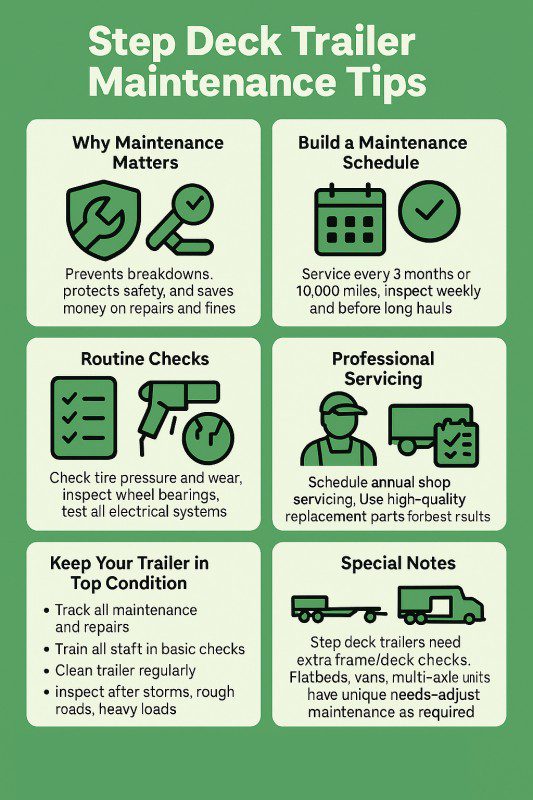Whether you haul machinery, construction materials, or heavy loads, step deck trailer maintenance is vital to safety and efficiency. Step deck trailers face unique stresses when you load tall or oversized gear, so maintaining your trailer closely helps prevent costly downtime. In this guide, you’ll learn maintenance tips that fight wear and tear, protect against wear and damage, and keep your rig in top condition for every haul.
Why Trailer Maintenance Matters
A maintained trailer stays reliable under heavy loads. When you ignore regular checks, small issues grow into major failures. Loose bolts, worn tires, or faulty lights can derail your schedule and endanger lives.
Good preventative maintenance saves you money on emergency repairs and helps you avoid fines for noncompliance with safety regulations. Whether you run local routes or cross-country trips, a sound maintenance schedule keeps you on the road, not in the shop.
Develop a Step Deck Trailer Maintenance Schedule
Start by mapping out a maintenance schedule that matches your mileage and cargo types. For many fleets, a full service every three months or every 10,000 miles works well. You should also plan quick inspections at the start of each week or before long hauls. Note these checkpoints on a calendar or digital app so you never miss regular maintenance. Consistency makes your rig safer and more efficient.
Routine Checks to Conduct
Inspect Tire Pressure and Wear
Tire failure ranks high among trailer breakdowns. You must regularly check tire pressure before every run. Under-inflated tires heat up and develop weak spots while over-inflated ones wear unevenly. Look for cracks, bulges, or uneven signs of wear across the tread. Rotate and replace tires when treads fall below the legal depth or show sidewall damage.
Examine Wheel Bearings
Your wheels spin on bearings that handle enormous weight. Inspect wheel bearings by lifting the trailer and shaking each wheel. If you feel play or hear grinding, remove, clean, grease, and repack bearings—or replace them if damage exceeds repair limits. Proper greasing cuts wear and tear and extends bearing life dramatically.
Check Electrical Systems
You rely on lights, signals, and ABS to guide other drivers. Test all lamps and wiring under load. Wiggle connectors and watch for flickers. Clean corroded contacts with dielectric grease and replace frayed wires. A solid electrical systems check keeps you legal and visible on every highway.
Preventative Maintenance Tasks
Grease Moving Parts
Lubricate hinges, slide rails, and landing gear jacks to fight rust and binding. Use high-quality grease rated for heavy loads and high temperatures. Greasing stops metal-on-metal wear and damage, so you avoid stuck components when you need them most.
Inspect Frame and Deck
Step deck trailers face extra stress at the drop between the top and bottom decks. Look for cracks, bends, or rust around welds and support beams. Scrape away loose paint and coat metal surfaces with a rust-inhibitor primer. A solid frame inspection lets you catch structural issues before they spread.
Test Brakes and Air Lines
Brakes absorb momentum from heavy loads. You must pull apart brake chambers and measure pushrod travel to ensure proper stroke length. Examine air lines for leaks or damage. Replace hoses with high-quality, abrasion-resistant tubing to keep your stopping power sharp.
Trailer Servicing and Repairs
Book Professional Servicing
Some tasks, like aligning axles or balancing wheels, require shop equipment. Schedule trailer servicing with a certified technician at least once a year. Professional shops also pressure-wash undercarriages to remove corrosive road salt or chemicals.
Use High Quality Replacement Parts
When your technician swaps parts, insist on high-quality components. Cheap bearings, straps, or hoses fail faster and cost more in the long run. Investing in strong parts pays off by boosting uptime and reducing the chance of catastrophic failures on busy routes.
Tips for Keeping a Maintained Trailer in Top Condition
- Track Maintenance Records: Log every service, part swap, and inspection. A paper or digital log helps you identify recurring issues and schedule upcoming checks.
- Train Your Team: Anyone who hooks up, loads, or inspects trailers should know basic maintenance tips. An extra pair of eyes catches signs of wear early.
- Monitor Loads: Heavy loads place more stress on your rig. Adjust your preventative maintenance frequency when you haul maximum weights or frequently run under harsh conditions.
- Clean Thoroughly: Wash off dirt and chemicals after winter runs or muddy sites. Clean trailers last longer and show issues faster.
- Inspect after severe conditions: Storms, floods, or rough terrain require an extra check for damage, wear, and tear.
Compare Maintenance Needs Across Types of Trailers
All trailers share core upkeep needs, but step deck designs add extra steps. Flatbeds require simple deck inspections, while enclosed vans need wall and roof checks. Multi-axle units call for more frequent bearing and brake service. No matter your rig, trailer maintenance remains the backbone of safe operations.

Step Deck Trailer Maintenance Tips: Conclusion
Regular maintenance keeps your step deck trailer roadworthy through every season and cargo type. You tackle wear and damage head-on by following a clear maintenance schedule, inspecting wheel bearings, testing electrical systems, and maintaining tire pressure.
Pair your DIY checks with annual professional trailer servicing and high-quality replacement parts for a maintained trailer that stays in top condition under heavy loads. Use these tips and preventative maintenance steps to extend your trailer’s life and protect your bottom line. Keep your rig running smoothly, and you’ll deliver every load on time.





